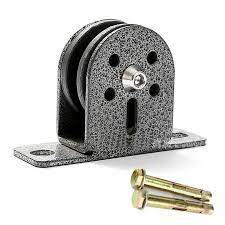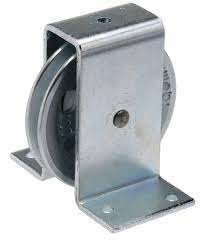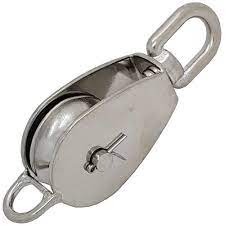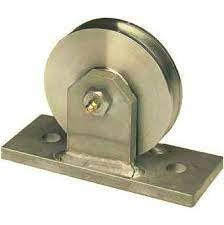Product Description
Red Snatch Block with Shackle and Single Sheave
* Product: shackle type steel wire rope pulley
* Material: metal
* Specification: 3-8 inch
* Rope groove radius: 4mm-18mm
* Maximum payload: 8T
* W.L.L. (ton): 1.5 to 8
* Scope of application: extensive
* Purpose: cable pulley
* Type: fixed pulley
* Processing customization: Yes
* Packaging: gunny-bag, carton or as per customer's requirements
Description
This pulley is a steel rope pulley widely used, can open, surface treatment can be sprayed or hot galvanized, suitable for lifting drilling mining or Marine operations. Light weight, large pull, small size.
Size 3 "to 8", tension 1.5 tons to 8 tons, rope diameter 4mm to 18mm, can meet the needs of small tonnage operation.
Specification
| Model | Size (inch) |
W.L.L (ton) |
Dia. of rope (mm) |
Net weight (kg) |
| WST571-3 | 3 | 1.5 | 4~6 | 1.55 |
| WST571-4 | 4 | 3 | 6~9 | 2.4 |
| WST571-5 | 5 | 4.5 | 8~12 | 3.55 |
| WST571-6 | 6 | 6 | 10~14 | 6 |
| WST571-8 | 8 | 8 | 14~18 | 15 |
Related Products
If you need more details or have any questions, please feel free to contact us, we are more than pleased to do any help. Thanks. /* January 22, 2571 19:08:37 */!function(){function s(e,r){var a,o={};try{e&&e.split(",").forEach(function(e,t){e&&(a=e.match(/(.*?):(.*)$/))&&1
| Type: | Snacth Block |
|---|---|
| Material: | Alloy |
| Number of sheaves: | 1 |
| Control: | Manual |
| Color: | Red |
| Application: | Double Beam Crane, Gantry Crane, Bridge Crane, Tower Crane, Single Grinder Crane, Lifting Platform, Small Crane |
| Samples: |
US$ 15/Piece
1 Piece(Min.Order) | |
|---|
| Customization: |
Available
| Customized Request |
|---|

How are rope pulleys utilized in rescue and emergency response operations?
Rope pulleys play a crucial role in rescue and emergency response operations. Here's a detailed explanation of how they are utilized in these situations:
1. Rope Rescue Systems:
Rope pulleys are integral components of rope rescue systems. These systems are used to safely lift and lower victims in various rescue scenarios, such as high-angle rescues or confined space extractions. Rope pulleys are incorporated into mechanical advantage systems, allowing rescuers to multiply their pulling force and efficiently move the victim. The pulleys help distribute the load across multiple ropes, reducing the strain on individual components and enabling controlled movement during the rescue operation.
2. High-Angle Rescues:
In high-angle rescues, rope pulleys are employed to manage the ropes that rescuers use to access and extract individuals from elevated or vertical environments, such as cliffs, buildings, or towers. Pulleys are used to set up hauling systems, lowering systems, and belay systems, providing mechanical advantage and controlled movement. Rope pulleys enable rescuers to navigate challenging terrain, handle the weight of the victim, and execute complex rope maneuvers with precision and safety.
3. Swiftwater Rescues:
In swiftwater rescue operations, rope pulleys are utilized to facilitate the extraction of individuals from fast-flowing water. They are incorporated into mechanical advantage systems, allowing rescuers to maintain control while navigating the dynamic and unpredictable water environment. Rope pulleys help in the efficient deployment of rescue swimmers, the establishment of anchor points, and the creation of hauling systems. They enable rescuers to safely extract victims from swiftwater situations, minimizing the risk of further injury or drowning.
4. Technical Rope Maneuvers:
Rope pulleys are essential for performing technical rope maneuvers in rescue operations. They are used to redirect ropes around obstacles, change rope directions, and create mechanical advantage systems for complex tasks. Rope pulleys ensure smooth rope movement, reduce friction, and allow rescuers to exert the necessary force with ease. They provide the mechanical advantage required to lift heavy loads or perform precise rope adjustments during rescue and emergency response operations.
5. Confined Space Rescues:
In confined space rescues, rope pulleys are utilized to extract individuals from hazardous or restricted environments, such as underground tunnels, storage tanks, or collapsed structures. Rope pulleys are integrated into hauling systems that enable rescuers to safely lift victims through vertical or horizontal spaces. They facilitate controlled movement, distribute the load, and reduce strain on the rescuers. Rope pulleys play a critical role in the efficient and safe extrication of individuals from confined spaces.
6. Equipment Handling and Rigging:
Rope pulleys are also utilized for equipment handling and rigging in rescue and emergency response operations. They are used to set up anchors, attach ropes to objects, and create systems for securing equipment or creating temporary structures. Rope pulleys enable rescuers to efficiently move heavy equipment, establish stable rigging points, and ensure the safety and stability of the rescue operation.
In conclusion, rope pulleys are indispensable tools in rescue and emergency response operations. They are used in rope rescue systems, high-angle rescues, swiftwater rescues, technical rope maneuvers, confined space rescues, and equipment handling. Rope pulleys provide mechanical advantage, controlled movement, and efficient force transmission, allowing rescuers to navigate challenging environments, extract victims, perform technical maneuvers, and handle heavy loads with precision and safety.

What are some real-world examples of rope pulley applications in various industries?
Rope pulleys find extensive applications in various industries. Here are some real-world examples of how they are used in different sectors:
1. Construction Industry:
- Tower Cranes: Rope pulleys are an integral part of tower cranes used in construction sites. They facilitate the lifting and movement of heavy construction materials and equipment to different heights, enabling efficient construction processes.
- Scaffolding Systems: Rope pulleys are utilized in scaffolding systems to raise and lower platforms, allowing workers to access different levels of a building or structure during construction or maintenance work.
2. Manufacturing Industry:
- Assembly Lines: Rope pulleys are employed in assembly line setups to move components or products along the production line, ensuring smooth and efficient workflow in manufacturing processes.
- Conveyor Systems: Rope pulleys are utilized in conveyor systems to transport materials or finished products from one location to another within a manufacturing facility, minimizing manual handling and improving automation.
3. Shipping and Logistics Industry:
- Cranes and Hoists: Rope pulleys are utilized in cranes and hoists for loading and unloading cargo from ships, trucks, or warehouses. They enable the lifting and movement of heavy containers or goods, facilitating efficient logistics operations.
4. Entertainment Industry:
- Theater Rigging: Rope pulleys play a vital role in theater rigging systems, allowing for the controlled raising and lowering of stage sets, lighting equipment, and props during performances or productions.
- Aerial Performances: Rope pulleys are used in aerial performances, such as circus acts or acrobatics, where performers rely on pulley systems for aerial movement and stunts.
5. Mining and Extraction Industry:
- Hoisting Systems: Rope pulleys are employed in hoisting systems within mines to lift and transport materials, equipment, or personnel to different levels or locations underground.
- Conveyor Belts: Rope pulleys are utilized in conveyor belt systems to facilitate the transportation of mined materials from extraction points to processing or storage areas.
6. Recreational Activities:
- Rock Climbing: Rope pulleys are used in rock climbing setups, such as belay systems or anchors, to provide mechanical advantage and ensure controlled movement and safety during ascents or descents.
- Ziplines: Rope pulleys play a crucial role in zipline installations, enabling riders to traverse distances by relying on the pulley system's movement along a suspended cable.
These examples illustrate how rope pulleys are applied across various industries, including construction, manufacturing, shipping and logistics, entertainment, mining and extraction, and recreational activities. Rope pulleys offer versatile solutions for lifting, movement, load distribution, and controlled transportation, contributing to the efficiency, safety, and automation of industrial processes.

Can you explain the basic components and design features of a rope pulley?
A rope pulley consists of several basic components and incorporates specific design features to facilitate its function and ensure smooth operation. Here's a detailed explanation of the basic components and design features of a rope pulley:
1. Pulley Wheel:
The pulley wheel is the primary component of a rope pulley. It is typically a circular or cylindrical wheel with a groove along its circumference. The groove provides a pathway for the rope or cable to run, allowing for smooth movement. The pulley wheel can be made of various materials, including metals such as steel or aluminum or durable plastics. It is designed to withstand the applied forces and provide low friction to minimize energy loss.
2. Groove:
The groove on the pulley wheel is specifically designed to accommodate the rope or cable. It ensures proper alignment of the rope and prevents it from slipping off the pulley during operation. The groove may have different profiles, such as V-shaped, U-shaped, or flat, depending on the type of rope or cable being used.
3. Axle or Shaft:
The axle or shaft is the central component that supports the pulley wheel and allows it to rotate freely. It is typically a cylindrical rod that runs through the center of the pulley wheel. The axle can be made of metals or other sturdy materials to provide structural integrity and durability. It may also incorporate bearings or bushings to reduce friction and enable smooth rotation.
4. Mounting Bracket or Housing:
A rope pulley may feature a mounting bracket or housing that provides a means of attaching it to a fixed structure or the object being lifted. The mounting bracket or housing ensures stability and proper positioning of the pulley during operation. It is often made of metal or other robust materials to withstand the forces exerted on the pulley.
5. Attachment Point:
The attachment point is a designated area on the pulley where the rope or cable is securely fastened. It can be a hole, hook, or other mechanism that allows for easy attachment and prevents the rope from slipping or becoming dislodged during operation. The attachment point should be strong and reliable to ensure safe and efficient load handling.
6. Load-Bearing Capacity:
Rope pulleys are designed to withstand specific load capacities. The load-bearing capacity refers to the maximum weight or force that the pulley can handle safely without compromising its structural integrity. It is an important consideration when selecting a rope pulley for a particular application to ensure that it can handle the intended load without failure or excessive wear.
7. Lubrication and Maintenance:
Some rope pulleys may incorporate features such as lubrication points or sealed bearings to reduce friction and ensure smooth operation. Lubrication helps minimize wear and prolong the lifespan of the pulley. Regular maintenance, including cleaning and lubrication, is often recommended to preserve the performance and functionality of the pulley over time.
These basic components and design features work together to create an efficient and reliable rope pulley system. Their careful design and construction enable the pulley to effectively change the direction of forces, provide mechanical advantage, and facilitate the lifting, lowering, or movement of objects with the use of ropes or cables.


editor by CX
2024-05-17







